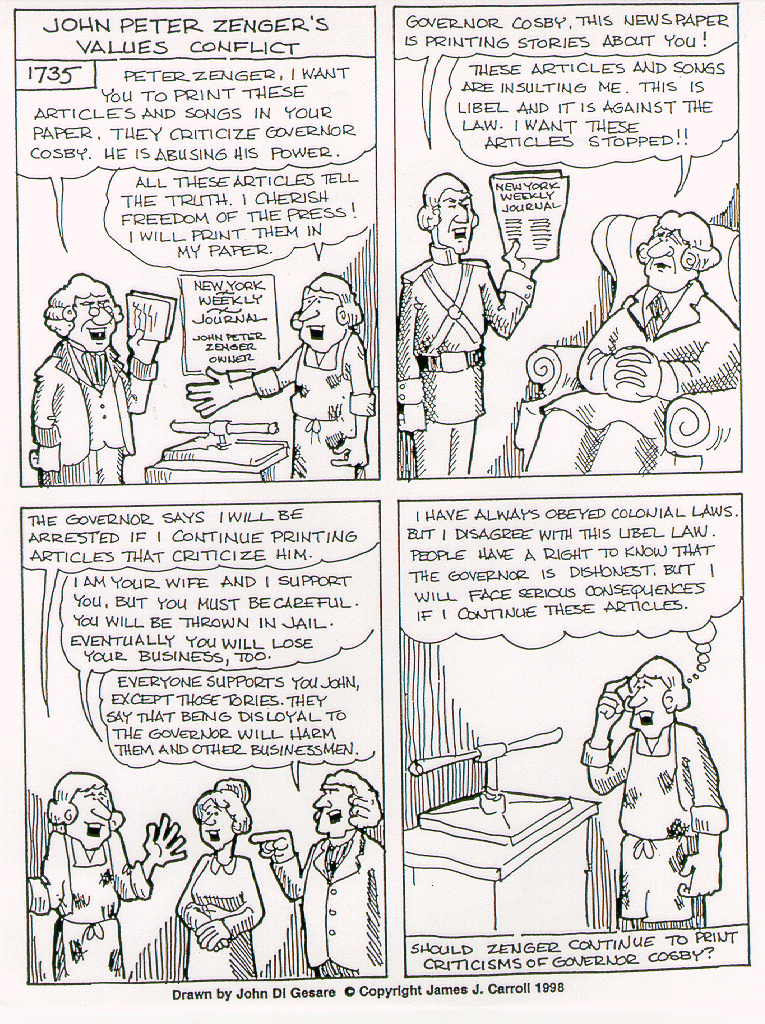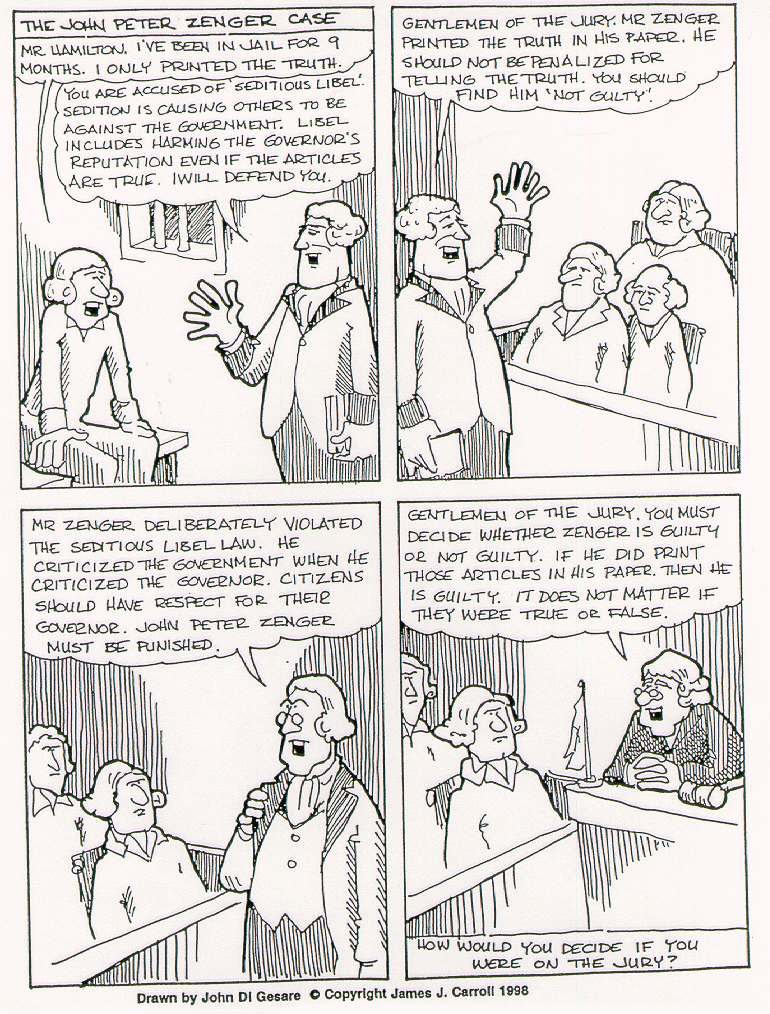|
Lesson 2: Speech & The Constitution
Topic:
What is libel?
Background:
Explain that today’s lesson will concern how this concept developed in our history and how it affects us today.
Objectives:
Students will be able to:
Differentiate between the meaning of the terms "libel" and "slander."
Role-play an historical values conflict and state the dilemma contained in the story.
Identify the various obligations that Zenger confronted in his dilemma.
State their own decision and reasoning for the Zenger trial.
Materials:
Handouts: 2A, "John Peter Zenger’s Values Conflict;" 2B, "The John Peter Zenger Case;" 2C, "Criticizing the Cafeteria Cook: Freedom of the Press or Libel?" 2D, "Libel suit nets $10,001 for former school cook."
Time Required:
1-2 class periods
Procedures:
1. Review briefly the meaning of the terms "libel" (written) and "slander" (spoken) as discussed in Lesson 1. Lead a Socratic dialog about the importance of having a good reputation and how false information about a person could damage someone; include specific examples of both ordinary people (perhaps students in the class) and famous people (celebrities, elected officials).
2. Select six students (5 males and 1 female), give them Handout 2A, and assign them the six characters depicted in the handout to role-play. Tell them that they can perform the first three frames of the visual for the class, and add a little dialog if they wish appropriate for their character; the role-play should end with the Zenger character stating his dilemma out loud to the class, as in frame #4.
3. After the role-play, have the entire class read Handout 2A. Arrange students in groups and have them brainstorm responses to the following question: "To whom or to what does Zenger have obligations concerning whether he should continue the articles?" Develop a list of the various responses: e.g., wife, conscience, Tories, law, prison, his supporters, etc. An optional activity would be to have groups rank order the top three criteria that should affect his decision. Have students share their opinions as to what Zenger should do and what criteria they are using for their decisions.
4. Read Handout 2B and discuss with students how they would decide if they were on the jury in 1735. For those who side with Zenger, ask if they would have felt justified then (or in another case today) in voting not guilty because they disagreed with the law. Be sure to stress at the end of the discussion that the main importance of this case is that it established the concept that "truth is a defense against libel."
Performance Assessment:
Distribute copies of Handout 2C, "Criticizing the Cafeteria Cook: Freedom of the Press or Libel?". This activity is intended to provide a real world analytical experience in which students would have to apply the type of knowledge and skills of a lawyer to an actual libel case that took place in a school district a few years ago. Students will find the subject matter very interesting. The analytical questions can be assigned either as an individual outside assignment or can be done as group work in class. Be sure that students make the connection to the Zenger principle that "Truth is a defense against libel" and therefore, if the article was untrue (i.e., Joe Green could not have seriously believed what he wrote about the food if he continued to eat it), Mrs. Crane wins. When students have completed the analysis of the case, share with them the actual newspaper account of the case--Handout 2D, "Libel suit nets $10,001 for former school cook." (NOTE: the newspaper article was edited for elementary students, deleting the phrase "for loss of wife’s services" following "$2,500 to Gagnon’s husband, James’).
Further Enrichment:
Based on multiple intelligence theory.
Linguistic: Students should write a letter to Peter Zenger explaining why they support his right to make negative comments about the governor.
Logical/Mathematical/Spatial: Divide the class into three groups. Each group should use eight pictures to create a visual storyboard on either libel or slander issues. The pictures should be placed in random order. The three groups will exchange storyboards. Each group will attempt to arrange another groups storyboard in sequential order. The storyboards will then be returned to the original group and the original group will critique the arrangement of the pictures.
Have students collect pictures from newspapers, tabloids and magazines that they believe are libelous.
Place the words libel and slander in the center of the chalkboard. Have students brainstorm words or ideas associated with libel and slander. Then have students create a chart comparing and contrasting libel and slander.
Divide students into groups. Tell the groups to make up a definition for the words, libel and slander based upon the Zenger case and the use of dictionaries. Have the groups share their definitions with the class and have the class select the best definition.
Kinesthetic: Students should create scenes about libel and slander issues, e.g. students spread untrue rumors about each other. Mini-trials should be conducted to resolve claims of libel and slander.
Intrapersonal: Students should close their eyes and reflect on something that was said or written about them, which they knew to be untrue. Ask students how they felt and what they did about the problem.
Ask students how they would feel if they were Peter Zenger and were prevented from criticizing the governor's speech.
Interpersonal: Students should divide into dyads (two's) and interview each other about the Zenger case. One student plays the role of Peter Zenger and the other student plays the role of the interviewer. Students should then change roles and conduct a second interview. A whole class discussion and a comparison of the two interviews should follow this.
Musical: Students could pair off and have a "rap" battle on libel or slander issues with other students providing the musical background using percussion instruments.
Ask students if music and song can also include examples of libel and slander.
A student or small group of students contacts a local newspaper reporter or editor or TV news program director, develops interview questions related to libel, conducts the interview, and develops a written and oral report on the specific types of libel issues that confront a local newspaper or TV station today.
HANDOUT 2A: SPEECH & THE CONSTITUTION

HANDOUT 2B: SPEECH & THE CONSTITUTION

HANDOUT 2C: SPEECH & THE CONSTITUTION
The Project LEGAL Times
Criticizing the Cafeteria Cook: Freedom of the Press or Libel?
|
SMALLTOWN, NY--
Last fall, the school year opened at Smalltown Elementary School as usual. Like every year, there were some new students, teachers and staff members. One of the new staff members was Mrs. Mary Crane, the new school cook. There was also a new teacher intern, Louise Jones.
Shortly after the school year started, many teachers and students began complaining about Mrs. Crane’s cooking. At the same time, Ms. Jones was starting a new student newspaper with her classes. "Be sure to use lots of adjectives in your stories," she told her students. |
One of her students, Joe Green, wrote an article about Mrs. Crane's cooking. The article was called, "Students Rebel Against New School Cook." His article said the cafeteria food was "not fit for a dog to eat" and "contained hair." The article called for the school to hire a new cook "with better credentials."
Mrs. Crane was fired before the article was published. Last week, the school newspaper was printed. People in Smalltown are making jokes about her cooking. She can probably never get another job in Smalltown as a cook.
|
Questions for Discussion:
1. What effect will the student newspaper article have on Mrs. Crane?
2. Do you think that Joe Green had a right to do an article about Mrs. Crane’s cooking for
the school newspaper? In other words, should it be protected as freedom of the press or
is it libel?. Explain your reasons.
3. If Mrs. Crane regards the article as libel, what legal action can she take?
4. Mrs. Crane hires a lawyer and sues the school district for libel. Her lawyer calls Joe
Green as a witness. What question should the lawyer ask Joe?
5. Who do you think should win? Why?
Handout 2D: SPEECH & THE CONSTITUTION
Syracuse Herald-Journal, Tuesday, February 19, 1985
Libel suit nets $10,001 for former school cook
ORISKANY FALLS (UPI) - Complaints by students about bad cafeteria food will cost the Oriskany Falls Union Free School District $10,001 in a libel suit filed by the district's former cook, the cook's attorney said Monday.
One newspaper article, "Students Rebel Against New School Cook," said the cafeteria food was "not fit for a dog to eat" and "contained hair." The article suggested the school hire a new cook "with better credentials."
Utica attorney Joseph Pachura Jr. said, "There was no evidence that there was anything wrong with her cooking."
Last week, a state Supreme Court jury awarded former cook Carol Gagnon of Oriskany Falls the money suit stemming from comments made in a newspaper in 1981 in connection with a project by 10th and 11th graders at Oriskany Falls High School.
Gagnon had been hired in January and was fired in March before the article appeared. She and an aide were the only cooks at the school.
"No one said, 'I tasted her cooking and it was bad,'" Pachura said.
The suit charged libel and negligence, claiming that Rebecca Pitkin, the teacher-intern working with the students, was not properly supervised by the district.
The jury awarded Gagnon $1 for libel, $7,500 for damages caused by the article and $2,500 to Gagnon's husband, James, for loss of his wife's services.
Pachura said the libel amount was so low because the publication was limited in scope and did not damage Gagnon's reputation in the community. He said Gagnon has suffered numerous physical ailments sine the article, including a weight gain of more than 85 pounds, and has not worked since she was fired.
During the trial, former District Superintendent Walter Buckoski testified Gagnon had been fired because of numerous complaints from students and faculty, a decline in lunchroom receipts and a failure to store food properly.
Pachura said Jack Ford, who wrote the article, admitted in court he ate the school lunch two or three times a week despite his written complaints about the food.
|